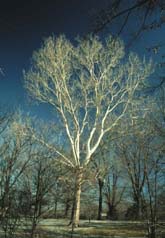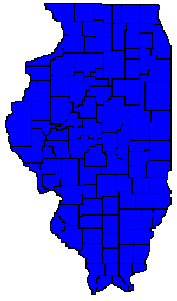 |
| Sycamore
(Platanus occidentalis)
Distribution
Map to Right |

Sycamore is one of the tallest deciduous trees in North America. It can grow to a height of up to 170 feet, with a trunk diameter of up to 8 to 12 feet. Tulip tree (Liriodendron tulipifera) is comparably tall, but generally does not have as massive a trunk. The crown is broad with large, irregular, spreading branches. Sycamore grows on floodplains along streams and around lakes and ponds. It occurs sometimes in upland mesic forests, moist ravines, and occasionally on limestone soils.
Interesting
Facts
The genus
name (Platanus) is derived from the Greek Platanos, which
in turn is probably from the Latin platys for the wide leaves. Another
name for sycamore is buttonwood. This common name arose from the fact that
sycamore wood, which is difficult to work with is also difficult to split
and is therefore used for butcher blocks and buttons.
Identifying Features
BarkUses
Older trees are easily recognized by their conspicuous bark. The bark is smooth and reddish brown to gray when the tree is young. As the tree ages, the bark flakes off in irregularly shaped plates exposing the white to yellowish gray under bark.
Twigs
The twigs are smooth and light brown.
Buds
The buds are light brown, small (1/4 inch long), and covered by the leaf stalk.
Leaves
Sycamore leaves are alternate, simple, and large; typically 6 to 10 inches long and often as broad. The overall shape is triangular, with three to five very large, sharp-pointed teeth. The leaves are green and shiny on the upper surface and are whitish and somewhat hairy beneath.
Flowers
Both male and female flowers occur on the same tree (monoecious) and appear in the spring (April - June) at leaf out.
Fruit
The fruit, which appears in October and persists through the winter, is actually a brown, spherical cluster (3/4 - 1 1/2 inches diameter) of dry, one-seeded fruits that hangs from a long stalk.
Sycamore wood is strong and hard, and is used for furniture, butcher blocks, and interior finishing. The tree is planted as an ornamental for its imposing stature and unusual bark. It is also a fast growing tree, often planted along streets.
Native Americans used sycamore for a wide variety of medicinal purposes, from treatment of coughs and respiratory distress to dietary and gastrointestinal aids.